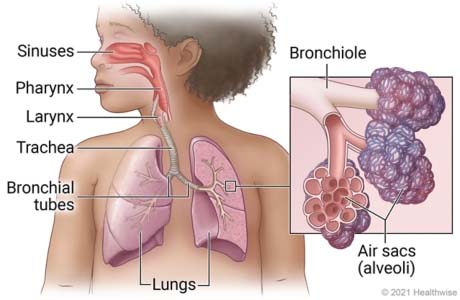Your airway (or respiratory system) moves air through your body to give oxygen to your blood.
Parts of the airway

Parts of a child’s airway and how they connect.
You breathe in through your nose and mouth, and the air moves down through your trachea (windpipe) and into your lungs.
When you breathe in, the upper airway (the nose and mouth to the epiglottis and the vocal cords) warms the air, provides moisture, and filters out tiny dust particles. The air travels down the trachea to the lower airway (bronchial tubes and lungs), which moves oxygen into your blood.
How a tracheostomy affects the body
Speech, sounds, and coughing
The vocal cords allow you to speak and cough, and they protect the airway when you eat and drink. The trach is inserted into the trachea, below the vocal cords. This is why your child may not be able to make sounds or talk when they first have a trach.
In time, some children learn to move air around the trach to make sounds. Other children can use devices to help them speak by sending air towards the vocal cords.
The end of the trachea splits to the right and left, leading to the lungs. The spot where it splits is a sensitive area called the carina. Anything that stimulates the carina, such as suctioning, can cause your child to cough.
Feeding
Behind the trachea is the esophagus, or food pipe. Your child may not be able to eat by mouth after a tracheostomy, and they may need a
feeding tube.
During your child’s hospital stay, your healthcare team will decide on the best way to feed your child based on their medical conditions. The healthcare team may check with experts in nutrition, swallowing, and long-term feeding-tube placement to understand what will work best for your child.
Some children can taste and swallow small amounts of certain types of food. If your child can take food by mouth, they may have a lowered sense of taste and smell, making them less interested in eating.
Moisture
When your child has a trach, the upper airway cannot make the air warm and moist. Your child needs a special humidifier to make the air warm and moist for them, so their mucus does not get thick, dried, and block the trach tube.
You will get a special humidifier with your home care equipment and a more portable heat moisture exchanger (HME).
